At Ruder Finn, we're obsessed with what's next - the trends, technologies, and ideas that are reshaping the worlds of business, communications, and creativity. This blog is a window into what we find fascinating, surprising and pushing the boundaries of what's possible. We want to hear from you, so sound off in the comments section. All opinions expressed are those of the individual contributors, not Ruder Finn.
Don't wanna be here? Send us removal request.
Text
The R(age) of Fake News in PR
By Varun Chakravarty, Assistant Account Manager, Ruder Finn India
“Journalists need experts as badly as experts need journalists.” ― Steven D. Levitt, Freakonomics
Jordan Peele’s Obama PSA recently took “fake news” to a new level. The video, which was digitally altered to believably look like Obama addressing the nation (while using explicative language about the current President), made us realize just how real fake news could look these days. This new age of digitally altered video and content is called deepfake, and is the new frontier in ‘fake news’ where artificial intelligence is used to make anyone say or do anything on video. Welcome to the era of “information apocalypse”.
Social media giants Facebook and Google have diffidently acknowledged that they have a real problem with fake news. It’s an issue that isn’t going away anytime soon, and in fact will only become more complicated over time. Fake news has infiltrated every industry, from consumer goods to politics, to even social activism. But what is not in question is the profound impact fake news poses for public relations practitioners.
Fake news is now becoming a resilient challenge in Public Relations. It’s gone from being a harmless annoyance to something that challenges the very essence of what public relations does well (earned media) and the relationships we build with journalists. The recent UNESCO report (on analysis of new trends in media freedom, pluralism, independence and the safety of journalists) highlighted how journalism is under fire amid rise of ‘fake news’ and social media-driven echo chambers. While more individuals have access to content than ever before, the combination of political polarization and technological change has facilitated the rapid spread of hate speech, misogyny and unverified ‘fake news’, often leading to disproportionate restrictions on freedom of expression. In this unmistakably changed world of earned media, questionable content, and potentially unethical representations of journalism, what can PR professionals do to counter-balance the fake news era and work toward a more trusted news universe?
1. Watch what you share: The biggest issue in fake news – if we can accept it – is us. The more fake news that is shared, the more widespread it comes. The complex algorithms and targeted automated services tend to accentuate posts that best capture audience attention, which is what bogus news is created to do. As PR professionals, we get excited about news, and often share, repost or link to news all day, but it’s important to check the source and confirm accuracy before sharing any content, as exciting as it may seem.
2. Be a trusted media source and be sure to work with trusted media: Provide journalists with accurate and current information they can share. With more audiences consuming their news on social media than ever before, we’ve moved a great deal of our content to less traditional online forms, often interacting with online influencers that don’t have a traditional journalism background. Be cautious about “new” media or web sites you haven’t heard of before. Be sure to check their credibility before sharing a news, in case it gets twisted into a “fake news” story or clickbait.
3. Beware of Content Blasts: You may inadvertently be working with fake news sites without even knowing it. Be cautious of digital advertising or content “blasts” that push your news out. While you may earn impressive impressions numbers, you may also unknowingly be running your content on sites with fake news or objectionable materials. Make sure you know exactly what sites your content is being blasted to before you move forward.
4. Don’t Discount Traditional Media.: While the popularity of social and online media as a primary news source isn’t going away, the foundation of traditional media remains steadfast. We are responsible as PR professionals to use all the tools in our cache to reach projected constituencies, and from where I sit, traditional media relations still have an important role to play in all of this. Make sure traditional media is still an important part of your outreach.
The bottom line for communication professionals: fake news is now a big part of the news cycle, and one that we must not just learn to live with but learn to work around and overcome. Fake news has the potential to undermine a core part of the impact that public relations generate for brands, and it is up to us as professionals to help protect the core of our industry. When the public distrusts the media, the third-party validation of getting earned media coverage vanishes. That validation beyond paid, shared, and owned media is critical, which is why media relations sector has always been such a crucial and an important part of the public relations practice.
0 notes
Text
A Tale of Two CEOs: Responding to a Public Crisis
By Pat Sartory
Earlier this month, two black men were arrested at a Starbucks in Philadelphia, after the store’s manager called police to say the men were trespassing. A video of police arresting the men, who hadn’t purchased anything and were quietly talking amongst themselves, went viral and sparked instant outrage. A firestorm erupted on social media, consumers called for a ban of Starbucks, and protesters gathered at the store.
In today’s climate, this incident could have dominated headlines for days and caused significant damage to Starbucks’ brand. But Starbucks CEO Kevin Johnson’s actions following the incident show how a proper public response can help mitigate damage, repair strained relationships with employees and customers, and restore public trust.
Private businesses have the right to remove people from their property, and there is no evidence that the manager violated any company policies. Yet Johnson delivered a full-throated and personal apology that struck the right tone and sent a clear message of contrition. In a public letter, video message and subsequent media interviews, Johnson apologized personally to the two men arrested, calling their treatment “reprehensible,” and apologized to his customers and partners. Johnson took full responsibility, and avoided carefully-crafted corporate speak that can make executive statements seem contrived and inauthentic. “These two gentlemen did not deserve what happened to them. And we are accountable. I am accountable,” Johnson said.
Importantly, Johnson also rejected calls to dismiss the manager who made the call to police, saying, “I believe that blame is misplaced. …I own it. This is a management issue, and I am accountable.” Rather than scapegoating an employee, Johnson took responsibility to address the issue and laid out his plans to fix the problem – ordering a review of company policies, vowing to meet with outside experts and community leaders to understand and adopt best practices, and offering additional store manager and training to recognize unconscious biases Johnson also called a company-wide meeting the following week to hear from employees, share learnings and discuss immediate next steps.
Johnson’s comprehensive and timely response is particularly informative, from a CEO communications standpoint, when compared to Facebook CEO Mark Zuckerberg’s response following the public outcry over his company’s handling of customer privacy and personal data. Instead of offering a prompt apology, Facebook initially deflected blame to Cambridge Analytica, offered confusing explanations around the timing of changes to their privacy policies, and allowed Zuckerberg’s deputies to address the issue publicly – all while Zuckerberg remained deafeningly silent. As the story continued to gain momentum in the media, Zuckerberg was finally forced to offer an authentic apology. This was an example of poor CEO communications and has since been dubbed a PR disaster (although Zuckerberg’s subsequent performance in front of Congress was quite successful).
Johnson’s actions in the wake of this crisis are another example of the evolving role of CEO communications in the modern era. More and more, CEOs are called on to be active communicators, and to take a stance on social issues on behalf of their companies. Mark Benioff of Salesforce, Paul Polman of Unilever, and Tim Cook of Apple are just a few examples. Kevin Johnson’s deft response to a crisis involving race and community relations sets a clear example for other corporate leaders to follow.
0 notes
Text
Thinking ‘Us’ instead of ‘I’
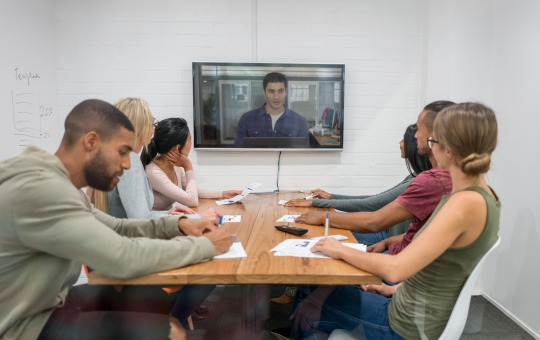
“Alone we can do so little; together we can do so much.” – Helen Keller
By Tripti Gusain, Senior Account Manager, Ruder Finn India
In the world of Communications, we often forget just how limitless our boundaries can be, beyond our four walls. In fact, in today’s global and dynamic workforce, distances and assigned boundaries should really be a way of the past. Global teams are collaborating more than ever – as we all are online 24 hours a day, whether we are in Singapore, Dubai or New York. The world has truly shrunk.
But what does this mean in terms of how we actually work together, and how we collectively work towards the same business goals, even if we never meet face-to-face? Even our clients, or prospective clients, are not seeing us segregated into countries or regions or nationalities – they want a collaborative team that can work seamlessly for the best results. As our workplace is becoming increasingly global, below are four things we can do to instill a more collaborative mindset in this global setting:
Make time for one another and find ways to share ideas. It’s easy to lose sight of opportunities for collaboration when people are not physically located in the same place. So take time to talk, and not just by email. Technologies that enable face-to-face connections, like Skype or FaceTime, can be a great way to more deeply connect during meetings, especially between remote locations, even if it’s just for a simple hello! This opens the door to many different cultural and geographical perspectives, while also helping teams stay up-to-date on projects and campaigns that are occurring in different regions of the world.
Empathize and be understanding. Collaboration can rarely occur without empathy. If I do not understand and empathize with the situation my colleagues or clients in the US, Hong Kong, or Beijing are experiencing, I will not be able to truly collaborate. It’s also important to be understanding. People from different countries speak in a variety of tones and styles. In some countries and cultures, an email could be seen as too straightforward, or even rude while it could be completely normal in others. Some cultures are more aggressive or docile than others. While cultural differences can make it difficult for us understand each other at times, a little bit of patience and empathy can enable us to collaborate in the most wondrous ways. For us at RF, spending time together with colleagues from around the world at the RF Academy last year was an important experience as it helped us better understand our global counterparts’ style of working, which could not be observed via online meetings or phone calls.
Celebrate cultures and share stories. One way to feel more global and integrated is to give one another more insight into not only the professional work, but cultural and personal celebrations as well. Sharing these unique moments on social media and other internal sites can help build or deepen relationships. A good and simple example of this is the RF Instagram Takeover where employees across different RF offices can witness photos and live videos of the culture and the work environment of a particular office.
Read up on global trends and perspectives. It is not only important to know what is happening inside your own region/country, but in this interconnected world, it is critical to be aware of news and trends happening in other regions as well. This way you will always be aware of the situation your global colleagues are going through.
Thinking globally and collaboratively means thinking smarter. Personally, I have always felt that borders and geographical separations are merely politically driven – we are one team and each of us plays an important part. We need to collaborate and create a stronger global team, as this is the ask and need of the interconnected world we live in.
0 notes
Text
Professional Healthcare Networks

By Camilla Arntzen
Social media and online networks are rapidly changing not only the way health information is shared, but also the way healthcare is practiced and how patients engage with healthcare providers. Not surprisingly, 53% of physician practices in the United States have a Facebook page and 60% of consumers say they trust doctors’ posts versus 36% who trust posts from a pharmaceutical firm. This makes physicians some of the most influential content “marketers” online, both with consumers as well as with each other.
Networks like SERMO and Doximity have been popular for years, but recently the field has expanded as technologies change, and companies and HCPs find new ways to use social media that are more tailored to the specific job at hand. As someone relatively new to healthcare communications, I am excited to see the opportunities emerge to go beyond traditional physician and patient communications such as blogs, chatrooms and controlled social content. In fact, healthcare professionals are now pushing the boundaries further than ever before, chartering new ground for what was once seen as an industry that relied only on regulated content. Below are some of the most exciting and innovative ways the healthcare industry is implementing social media and pushing boundaries:
Education Through Instagram: Instagram has proven to be more than just fun platform to share photos and stories. It is a platform and medium that accelerates access to everything happening in the world in real time – and for doctors, real time can make all the difference in a patient’s life. For example, a new firm, Figure1, adopted the huge popularity of Instagram into its thinking, and launched an Instagram-like service for doctors where they share images across 100 countries to educate others and get input on patient images and rare illnesses. This is a big leap from the traditional, dialogue heavy networking sites of the recent decade.
Specialized Communities: Due to the clinical nature of HCPs conversations, and an unwillingness to have those conversations on existing social channels, platforms targeted at a specific disease state, treatment options or practice have popped up. These are places where like-minded verified healthcare professional can communicate and collaborate on patient cases. For example, Skipta has taken a decidedly vertical approach to HCP social networking, launching very specific communities for 30 types of specialists.
Localized Communities: Doctors have largely had to rely on the U.S. for information coming from healthcare networks. Meanwhile, treatment and medicines can vary depending on the country. Companies are looking at the potential for more localized networking platforms, working with international doctors for local issues. Combining elements of social networks and medical journals, DailyRounds unites doctors and provides information such as locally available drugs.
Educational Networks: Communication and collaboration has led to an increase in demand to see prepackaged presentations on the latest science and medicine. These educational networks are less of a social network and more a learning and collaboration platform. For example, QuantiaMD is a platform that helps physicians stay ahead by interacting with and learning from experts and peers. Similar would be Incision Academy, which helps surgeons share their techniques with other surgeons across the world.
It is fair to say these HCP-focused networking sites offer connection, education and crowd-sourcing opportunities in a broader, more organized way than ever before. One of the benefits of the increase in social networks for HCPs is that it gives healthcare companies a new channel to reach targeted healthcare audiences in new ways. For example, healthcare companies are better able to identify and track unmet needs and proactively work to provide solutions. Alternatively, we can zoom in on specific disease states or treatments, know what doctors are looking for, and target outreach and messaging accordingly. A recent survey found that information on social media can have a direct influence on patient’s decisions to seek a second opinion or choose a specific provider, particularly for people who are coping with a chronic condition. That being said, these platforms give us to opportunity to make sure the appropriate information finds the right person.
Moving forward, we expect these networks to continue expanding as HCPs grow more comfortable with social media and its benefits. Already, 88% of physicians use the Internet and social media to research pharmaceutical, biotech, and medical devices. No longer just used for communicating and connecting, networking platforms will continue to change how medicine is discussed and transmuted globally. Times are changing, and the health care industry is taking more risks when it comes to social media. This shift in attitude means pioneering new ways to use “social” channels in a more meaningful way beyond just being social.
0 notes
Text
How VR is Disrupting PR
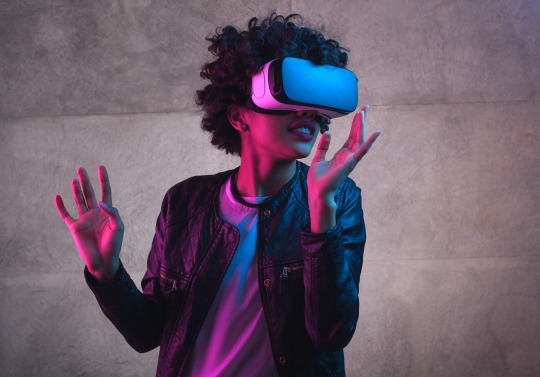
By Liz Morgan
As communicators, we are also storytellers, marketers and creators of social and IRL experiences. So it’s not surprising that VR is becoming more advanced, and more ingrained into the world of PR. At Ruder Finn, we have used VR for both internal and external campaigns for clients over the years, but are always looking for ways to take the technology further and gain a deeper understanding as it evolves.
One way VR is changing and becoming more prominent for PR is through virtual ads, which allow a user to experience an event through interactive 360 videos and photos that “transport” the viewer to another time and place. You can scroll around the video to see all angles and aspects to the virtual view of the experience. For example, this Pinterest pin of a Home Depot room allows you to you virtually step into a room containing ‘hot spots’ where you can click on products to purchase. Virtual ads have evolved over the years from being primarily viewed in more stagnant places like billboards and football stadiums, to now jumping out of your phone and giving the user a more personalized experience.
This capability positions VR as less of a “techy” thing and more of an approachable, everyday innovation that can become commonplace.
While virtual reality is still growing in the world of PR, there are a few areas where I believe it will make the most impact in our industry in the short term:
Customer Experience: VR will allow consumers to better comprehend a brand or product by truly ‘experiencing’ it, which hopefully will lead to a better understanding of a brand. A number of brands have already started using VR to improve customer experience. For example. IKEA gives prospective kitchen customers the ability to explore ideas and possibilities for their kitchen via an app and VR headset.
Patient Experience: One area where VR is unexpectedly making huge strides is in healthcare. With VR, patients can have a remote session with a doctor or specialist and has been used to help patients, especially children, ease anxiety around needles and other treatments. VR has also helped doctors improve care though simulations that prepare them for real-life medical emergencies and surgeries.
Storytelling and activations: Virtual reality can help bring a brand’s story to life, as well as immerse users in a branded entertainment experience through pop-up and virtual events. For example, last year Game of Thrones promoted their upcoming season by posting a 360-degree video on the show’s Facebook page, which quickly became Facebook’s most viewed video with 5.3 million views in the first 24 hours.
Product testing: While it was once necessary to physically experience a product to test it, now consumers can assess products in a realistic way without physically touching it. For example, retailers have been using “memory mirrors” to recommend products from beauty and skin care (Sephora) to fashion (Neiman Marcus.) WalMart also recently announced the use of VR in their make-up department.
Making VR easier for people to consume, makes it fair game for PR campaigns in all industries. VR is not a fleeting trend, it is here to stay, and the time is now to get real about just how much VR can help elevate brands and increase customer engagement in exciting new ways.
#virtual reality#vr#disruption#public relations#pr#walmart#sephora#home depot#neiman marcus#ikea#facebook
0 notes
Text
The AI Race Is On, But the Finish Line is Beyond the Horizon
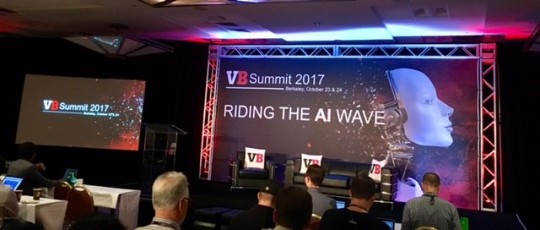
By Jackie Weisberg
I recently had the opportunity to attend the VentureBeat AI Summit in San Francisco, which gathered senior leaders across various industries to discuss the explosion of AI in business, specifically focusing discussion around how today’s leaders are using AI to extract meaningful ROI.
After listening to experts across various industries, ranging from HR to retail to transportation, share their experiences with AI, one thing is certain: AI is here and it’s here to stay. By 2020, research firm IDC predicts, AI will help drive worldwide revenues to over $47 billion, up from $8 billion in 2016 – that’s a whopping difference of $39 billion.
Before delving into the global business case of AI, let’s bring the concept a bit closer to home. Just think: When was the last time you asked Alexa to turn off your lights, requested Siri to play your favorite song, or perused your Netflix recommendations? Likely, these have become everyday habits (I can’t even think about the hours I’d get back if I hadn’t looked at my Netflix recommendations...). The point is: we’ve already begun taking these intelligent machines for granted, hardly giving a second thought to the technology and algorithms running the back-end.
Just as AI seeps into our personal lives, it is also transforming the very essence of business – inducing a radical shift in the workplace. Lyft is using AI algorithms to pair consumers with drivers, Pinterest is relying on AI to learn, and then sell, your style, and Walmart is implementing AI technology to sell items online. The use cases of AI are truly limitless – and this is only the tip of the iceberg.
Below are a few points I’ve taken away from the conference that may help quell concerns and misunderstandings about AI’s effect on business:
Don’t fear AI: The robot revolution continues to dominate the news cycle, with employees and companies alike questioning what their job will look like – or if it will even exist - in the next few years. Yes, AI will render many jobs obsolete, but it’s more important to think about the new professions and in-demand skillsets being created as result.
AI will automate 1.8 million people out of work by 2020, but it will also create 2.3 million jobs - driving a net gain of 500,000 new jobs. As the VP of AI at LinkedIn mentioned during his key note, “The demand for AI across the company has increased enormously,” but instead of concentrating on what jobs won’t be here in the age of automation, we must accept that the future of work is man and machine working together – and then figure out what skills we need to acquire to stay relevant.
Get education in place, as soon as possible: One of the biggest challenges with AI is a shortage of talent. According to The New York Times, there are fewer than 10,000 people have the skills necessary to tackle serious artificial intelligence research. To reskill for the digital age, companies must take a nod from those companies (among the likes of LinkedIn, Facebook and Google) who are already educating and reskilling their employees on the AI-related skills needed to usher in the next wave of innovation.
Embrace a new era of communications: AI is revolutionizing customer experience, dramatically changing how brands reach and interact with their internal and external audiences. With AI-fueled products such AI assistants and chatbots, companies can now engage with stakeholders 24/7, in ways that mimic genuine human interaction.
Thus it’s no surprise that 80 percent of businesses plan to have chatbots by 2020. Chatbots are streamlining services and delivering heightened customer experiences across all industries. My personal favorite: The Starbucks’s chatbot, which allows customers to place their drink order via simple voice commands or text messaging in the app. The chatbot even tells customers the ETA on their order - finally, a solution to the morning caffeine rush!
And, AI is already being used here at Ruder Finn. I recently explored Ruder Finn’s new Alexa skill, “Kathy's Thoughts” and it was fascinated to see how the voice-activated technology was able to automate conversations in a personal and authentic manner.
Finally: Remember, AI is not a “quick fix” or magic solution: Don’t believe the hype; AI is not a panacea for every business’ problems. When deciding whether to implement AI, companies must consider what experiences customers are looking for and what problems they are trying to solve. After taking this into account, companies can more accurately decide if an AI-driven approach is the most tactical for their long-term agenda.
The Fourth Revolution is here, and it’s AI. But, envisaging the future is a delicate game - only time will tell AI’s full potential.
0 notes
Text
Making friends with millennials and Gen-Z: The new consumer brand imperative

By Connie Wang
I recently had the opportunity to attend PR Week’s Swipe Right conference in New York – it was a fascinating day-long look at the young people driving today’s consumer landscape: Millennials and Gen-z. Who are they? What do they value? And how can we as marketers and communicators effectively engage with them to build our brands?
It’s imperative to understand that people and generations are defined by the key social and cultural events that happen in their formative years – their adolescence. For U.S. millennials (born roughly 1980-1995), the tragic event of 9/11 was transformative, while for Gen-Z (born ~1995-2000 on), it was the U.S. financial crisis of 2007-2008. These two key events, along with other milestones such as the advancement of the internet age and proliferation of smart mobile devices, the election of our country’s first black president, and the legalization of gay marriage, have led to a cohort of young people who are broadly defined by values like: Stability. Equality. Making the world a better place. Practical success. And individuality over diversity.
Values like these are how Millennials and Gen-Z make friends and relate to the people around them. These values also extend to brands. As a Millennial myself, one of the fascinating learnings from Swipe Right was the insight that, our favorite brand is ourselves. We use brands to build ourselves. We don’t buy products, we join brands – but only if they measure up to our values. Below are a few points I’ve taken away from the conference that help define how Millennials and Gen Zers engage with brands:
Brands Have to Work Harder For Loyalty. But The Right Digital Content Gains Trust. We know, we’re different ❄. According to a survey from Adroit Digital, 78% of young people say brands have to work harder to earn our brand loyalty than they did to earn our parents’ brand loyalty. And we evaluate brands on a different set of criteria – 62% of us feel that digital content drives brand loyalty. Hear that, marketer friends? If you can be authentic – and do it on the channels we frequent, and maybe even tap an influencer friend to help you make the case –we could get into it.
If You “Wow” Us, We Are All Yours. Case in point: Chieh Huang’s talk at Swipe Right blew me away, and I’m now completely obsessed with his company. As the CEO of Boxed, aka the digital “Costco for millennials”, Huang has infused his values into the culture and way of working at Boxed. For example, they have formalized female employees’ protest of the so-called “pink tax” – the 5-9% in sales taxes levied on “nonessential” feminine products like tampons and razors. Boxed actually discounts prices for these items on their site, to offset the tax that many people find unfair. Add to this a mindset of promoting from within, and generous benefits like paying for employees’ weddings and their kids’ educations – I’m in. Read all about it here.
The Brand is the Message. Some interesting research from MWW found that one-third of the population, including Millennials and Gen-Z, thinks that the way a company acts is just as important as the stuff it sells. Two-thirds of this segment would pay full price for a product they believe in, and over half would support unsatisfactory products, just because they support the company overall. With these kinds of numbers, brands can’t afford to get it wrong.
So overall, while Millennials and Gen-Zers may sometimes get a bad rap, the bottom line is that we are highly engaged, highly likely to be influenced and influential, and highly motivated to rally around a cause we believe in. Just don’t do anything that turns us off… because we may “swipe left” before you have a chance to apologize.
0 notes
Text
The Panel that Wasn’t: What’s Next for Women in Tech

By Brianna (Mulligan) Rabe
Last week was Washington D.C.’s inaugural TechWeek. While many sessions explored emerging technologies and startups targeted on disrupting the status quo, the first event I attended addressed what I believe is the most important challenge facing the industry: women in tech. The discussion took place at George Washington University, and featured panelists from across the tech sector: PhD students, cybersecurity, IT, consulting. The session however, was nothing what I expected: because it, in fact, did not discuss women in tech.
Let’s take a step back. I’m one of the incredibly lucky women who has had the chance to grow my career in an environment lead by successful, motivated, and inspiration women. Ruder Finn has a legacy of female empowerment: our CEO is an industry legend, and our CFO, Global Head of Technology, US Head of Healthcare, and so many other leaders are also women. But, not every agency (or even industry) is as lucky- and I don’t need to quote the dismal statistics to prove my point.
That said, I was intrigued to hear what these successful women, who pursued and excelled in a male-dominated field of technology, would have to say about the unique challenges they faced and how they overcome. The answer is: a lot less than I expected. Which was, it turns out, the best thing. Because, instead of discussing how to be pursue a career in technology as a woman, the discussion addressed how to pursue a career in technology.
The conversation addressed key accomplishments, obstacles overcome, advice for younger generations, and key lessons learned. The women on the panel worked on projects ranging from organ donation vans to the Harry Potter films (author note: I geeked out during this story); and discussed emerging and outdated technologies about which they were passionate. And, the key take ways were applicable to anyone in the tech industry, not just women, including:
Be your own advocate: It’s important for people to see that you are contributing and to showcase your success. By documenting your hard work and making yourself visible, you are demonstrating how you are integral to the team and positioning yourself for success.
Work across departments and with different types of people: Working across departments and with people who have different talents, you understand not only where your skills can fit in, but what skills you should develop. Throughout your life, you’ll be working with different people- and learning collaboration will ensure success.
Don’t be afraid to leap: You don’t have to know if it’s where you should be, but don’t be nervous to make the change. What is important is to know you’re pursuing something that truly aligns with what you want to do. With so much out there, having options is a great thing- you can dictate where your talents will fall.
Always continue to learn: There are always new opportunities to hone your skills, or learning something entirely new. Pursue those relentlessly. And remember, you don’t have to know how to do everything when you raise your hand- look for challenges and learn as you go.
Diversity is having different people at the table, inclusion is having them speak: Look for cultures and the type of people where you feel you will be involved and have a say.
Don’t get me wrong, there were definitely some comments that were unique to the women in the audience. For example, two of the women on the panel talked about how they were most proud of projects they completed with their teams while they were pregnant- and the unique challenges that posed.
The panelists, and attendees, did discuss how to address these systematic issues, and how each person can help usher in the changes. For example:
Be inclusive, both in the office and outside: For example, company events may all revolve around alcohol, but for young mothers, pregnant women, or those trying for children, alcohol isn’t part of their lives. Culture needs to shift to be more inclusive; and cultural leaders should take everyone into consideration when planning team events.
Talk to the right people: Mentoring tends to be a solve-all for these types of conversations, but it’s importance cannot be understated. Having someone you can talk to; or being someone who can offer support; helps everyone. And, this includes during the interviewing and onboarding process. If you are interviewing for a new job, ask to speak to a female leader (if a company doesn’t have one, that’s could be a red flag right there.)
Management needs to not just pay attention to the start of the pipeline, but the leaks further down: The percentage of women who drop of tech after 10 years is staggering high. Organization leaders need to address the best way to retain talent, not just attract it.
Invest in and support your talent: This is a piece of advice for leaders. Women in tech careers (and in the workforce in general) have an incredible drop-off rate when they start having families. Companies that offer flexible benefits- from the ability to work from home, stipends for childcare, or generous family leave- are going to be the most likely to retain key talent.
That said, a majority of the conversation focused on general themes in tech, and career advice from successful people. I’m not saying that the field has evened, but I was inspired and impressed by the conversation. The more we normalize the “concept” of women in tech, the better. Maybe, one day, we won’t have to be having gender-specific conversations. And discussions like this mean that future may be on the horizon.
0 notes
Text
The five most fascinating people at Advertising Week 2017
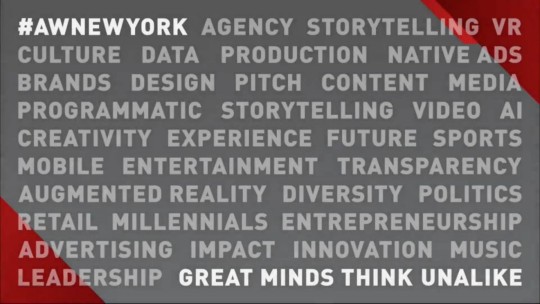
By Christine Dusek
In the spirit of the famed Barbara Walters’ television interview events, I am sharing my choices for the five most interesting and prominent personalities who I was lucky enough to hear speak at AdWeek. (#AWNewYork) Their remarkable capabilities and forward-thinking viewpoints are what defines them as today’s emerging media industry icons. I took away not only a very healthy respect (and interest in doing their PR) for what they do each day but, also, for how tapped in they are to today’s culture moments, showcasing the diversity that defines the United States, how what was once a social channel is morphing into one of the most influential platform for communications campaigns, and the need to understand all this to be an effective communications strategist.
1. Bozoma St. John, first Chief Brand Officer, Uber: Bozoma was in the “Wired Brand Storyteller” session, along with Jennifer Breithaupt, global consumer CMO officer of Citi, and Marc Mathieu, CMO of Samsung Electronics. But the ever-impressive Bozoma, current chief brand officer of Uber and former Apple Music and PepsiCo (think Beyonce campaigns) marketing icon, was the real rock star of the session. Not only is she leading the charge of humanizing the Uber brand, coming off a long string of public scandals and a leadership crisis (Uber is hoping a little marketing mojo can help it regain its footing – the whole reason I sat in the room for this one), but she owns her remarkable position as one of the few senior women of color in Silicon Valley. All three marketing execs are master brand storytellers and, while the dialogue was continually dynamic, there were a few key takeaways from this session. First, brands don't want to be politicized, they want to be humanized. That means connecting brands to culture, and finding what's important to their consumers. Second, diversity of thought and images matters, and should reflect your audience. But the biggest takeaway was quite simple - using familiar music soundtracks, powerful visuals, and a storyline that hits at life moments that are important to consumers, is how you build audience interest and brand following.
2. Iram Khan, CSO, Snap: This former banker is a super-impressive speaker, who gave an articulate overview of how Snap can best fit into marketing and advertising efforts. But the interesting takeaway from his panel was that, while video is still “everything,” the trend is that videos are getting shorter and shorter, and Snap CSO Khan even went so far as to say that video now needs to be no longer than 3-5 seconds. He showed us some great examples of the next version launch of the “Call of Duty” video game, and how Snap previewed the video game with a simple 3-second video of Normandy Beach, and the headline of the game. They also showcased the amazing traction they got on the “Game of Thrones” promo work with HBO, and the use of the ‘white walkers’ to attract super-fans with an ice-blue-eyed geo-filter during the premier episode. They even had the cast of GOT using the filter on the red carpet premier, and posting to the official show’s snap channel
3. Carolyn Everson, Facebook’s VP of global marketing solutions, used her slot at Advertising Week to talk about Facebook’s “accordion of options” for marketers when it comes to video. Given all the interest in video at this event, I wanted to hear Facebook’s take on the opportunity, and how that might impact other competitors’ narratives. Video feeds are now clearly evident, as proven when I opened my Facebook app during the session and was greeted with a slew of short video teasers accompanying posts. I also learned, in this session, that Instagram is now up to 800 million monthly active users, and that half a billion accounts use it every single day. (Take that, Snapchat!) Ms. Everson also said she thinks the industry is underestimating the potential of mobile. Given that mobile represents around 87% of Facebook’s ad revenue, it made a lot of sense for her to bring up this interesting fact!
4. Sarah Jessica Parker: SJP was fabulous for just being SJP on the Instagram Effect panel discussion, moderated by Rebecca Jarvis, and for inspiring me and other (ahem) non-Millennial remarkable female business women to finally get an Instagram account (especially after sitting through Carolyn’s Facebook pitch!). She is the master at carefully curating her own personal brand, with over 3.7 million followers on IG, and uses a beautifully curated Instagram gallery of video shorts, photos, and memes to tell the story of her life and her iconic personal brand. Thanks for the tips on how to build my own authentic personal brand without being a celebrity. Oh, and those shoes were just the best….never disappointing!!!
5. Tim Armstrong, CEO, AND Allie Kline, CMO, Oath: These two presenters drew everyone’s attention not only to their new corporate brand campaign that launched during AdWeek but, also, to their successful storybook narrative, and seamless integration of anecdotes about the future of ‘brand-building’ on their platforms (shameless plug for my client!!!). Oath did a rock-star job launching its new brand campaign, and was omnipresent at every venue in terms of rolling out advertising highlights about the brand, featuring analytics about their media and advertising properties, and using a cool new video ad with a rap-inspired remix from ChuckD and Tribe Called Quest (“Can you kick it”) to showcase their brands and their coolest clients. Their leadership team was also present as keynoters and panelists at all the top-draw events, including a ‘center stage’ keynote appearance by CEO Tim Armstrong, who highlighted his platform for the “Building your brand with Oath” campaign, which is all about how to use amazing creative, even better content, and great ad tech metrics to effectively build brands. Finally, the entire campaign ‘buzz’ was shaped by an AdWeek feature article that dropped on Monday, followed by additional coverage in WSJ, Marketing Week, Bloomberg, BI, The Campaign, CNBC. The trick to AdWeek, I’ve learned, is to have amazing videos, find the media onsite, and say something soundbyte-worthy. It was a fulfilling week of learning, networking and even some celebrity sighting, and I’m truly inspired to make the ideas a reality!
AdWeek remains the place to be seen and heard, and my key takeaways help us to be better communicator partners to advertisers and marketers:
Video is everything: If there is one thing that reigns true, it’s that video is king. Videos are the medium of choice and, with the increase in popularity of Snap and IG stories, video has to be a part of the content – and the shorter the better. It’s clear attention spans are getting shorter, and brands need to incorporate shorter but buzz-worthy video, either as a stand-alone or to accompany written content.
Humanize brands: With the rise of social media, everyone wants to feel a personal connection with the people and brands they follow. To this, brands need to think less about selling products and more about selling an experience and lifestyle. This means that content needs to be less self-serving and more about the people and moments behind the brand.
Story-making vs storytelling: Storytelling has been a theme in our industry for a while, but now we need to look at storytelling not just as “telling” but as “curating.” This means that stories the brands tell need to evolve, and build off one another, so that the consumers have an ongoing, dynamic and engaging experience.
Diversity takes on many dimensions: When we think of diversity, we need to think about not just outward diversity, but diversity of experience, thought and skills. This means agency staffing models need to move from siloed approaches to those that incorporate people who have very varied backgrounds and experiences in different industries – for example, staffing a healthcare account with someone with a tech background, or a food and beverage account with someone with a health background. What this can lead to is really unique, creative ideas that think beyond traditional boundaries.
0 notes
Text
Defining the ROI of Connected Communications

By Lisa Carson
It’s no secret that every campaign is different. Every communication contains its own unique objective and execution. Why, then, is efficacy treated with such a wide stroke? When it comes to justifying the investment of a particular campaign or communication, there are more tools than ever to validate the spend, yet we continue to fall back on the same measurements. This week, RF gathered with the brightest minds in marketing to discuss exactly this at Advertising Week in the heart of Times Square. In an industry that often uses impressions, engagements and reach, how can we get a better view of what’s working and what’s not?
Jeff Weiser, CMO of Shutterstock, was keen on answering this exact question during his seminar entitled “The ROI of Becoming Data-Driven: How Do You Measure Success?” Jeff, a veteran of building unique metrics models and reporting systems, explained his approach to defining ROI when the communications judged are tangled together in a larger web of efforts. In Jeff’s view, most marketers assign a disproportionate amount of credit to the last click a consumer makes before a desired action is completed. If a consumer has involved four different touchpoints before clicking through a banner ad, that ad gets all the credit for efficacy, though it didn’t make the sale alone. By focusing on “last click attribution,” we lose a sense of how the greater marketing mix works together to create a desired outcome, and lose out on opportunities to pump needed support into diversified efforts.
So how, then, do we assign value across the entire marketing ecosystem? Each model is different, but all that are balanced against giving an unfair advantage to that last click share one commonality: they measure how a single communication funnels consumers to further communications, instead of focusing on how communications funnel consumers to the final action or sale. By linking communications, and demonstrating that consumers ping between them, marketers can more effectively measure which communications are the powerhouses of the ecosystem, and support them. Sounds simple but, in practice, this requires revising metrics reporting to focus on content connectivity over campaign outcome. This in itself requires an open mind and plenty of collaboration – between both team members and clients.
All in all, demonstrating the value of a campaign is never turnkey. However, we do have the opportunity to monitor our efforts with unprecedented precision and focus, which help us to fully define the value across the entire ecosystem of communications – which is a very good thing. Because while this may be a new way of measuring ourselves, the actual consumer behavior has been unfolding all along.
0 notes
Text
3 things from TEDGlobal>NYC: Silicon Valley’s trust problem; rethinking emotional intelligence; re-framing the narrative for change
By Robin Kim

It was no coincidence that TED’s Global NYC Town Hall took place during the UN General Assembly in New York last week. Its mission was to catalyze new thinking about world issues, and it welcomed UN visitors as well as a myriad of other global thinkers and doers. Three things struck me from that event.
First, the public love affair with Silicon Valley is over – and it will likely stay that way. Speakers from CNN’s Christiane Amanpour, to EU Commissioner for Competition Margrethe Vestager, to techno-sociolost Zeynep Tufekci, added their voices to a growing chorus of critics who view the tech sector’s biggest giants as vulnerable to spreading bias and fake news, and threatening privacy, competition and jobs. None of these speakers thought Facebook, Google and Amazon were evil, but each believed that in the quest for global dominance, these companies are creating technologies they can’t fully control. Sheryl Sandberg’s own statement would suggest she agrees with them. “We never intended or anticipated this functionality being used this way,” she wrote, “and that is on us.”
Second, the high level of attention given to algorithms and big data is overshadowing the urgent need for greater emotional intelligence. Author Elif Shafak observed that when communities experience too much change and uncertainty too quickly, the response is to retrench and return to simplicity, which can enable demagoguery. Demagogues define issues – and people -- in all-or-nothing terms, stripping them of their complexity and diversity. The result makes for sexy headlines, but it does little to broaden our thinking beyond dualities toward meaningful, complex problem solving. Only empathy enables us to celebrate diversity for what it is -- plural, nuanced, multi-dimensional, competing… and ultimately co-existing. We need to tackle gaps in emotional intelligence if we’re to change mindsets and seek solutions that unite versus divide. Shafak received a standing ovation for her words.
Third, we will need to reframe the narrative for change if we are to solve our biggest global problems. Issues are naturally interconnected, yet activist author Naomi Klein observed that discussions on solutions are often siloed: poverty reduction advocates for example, don’t often cross into climate change, even though poor people are hit most by its consequences. Resisting bad policies are not be enough: we must begin with a clear vision of the world we want to create. She showed how when we start from that vantage, the issues we fight for will become more intuitively interconnected, as well its champions. This is how movements are made.
There were several calls to action that I walked away with from this discussion. We must be more responsible and discerning on the sources of what we read, watch and share – and teach and hold others accountable for the same. We need to embrace the type of storytelling that broadens understanding and celebrates complexity, vs. narrowcast our heroes and villains. And we need to consciously, proactively drive to yes, versus simply knowing what we are saying no to. Those and more are ideas worth spreading.
0 notes
Text
Humanizing Digital: Why digital strategies need to be anchored by our human connection

Brianna Rabe, Vice President, RF Tech
At the beginning of September, I had the opportunity to attend the inaugural Digital Summit: Washington, D.C. The event, heralded as the “definitive digital marketing gathering,” brought together men and women from all industries, walks of life, and experiences to discuss the role of digital; and how emerging and existing platforms, technologies, and ways of thinking are directing their organization’s marketing and technology strategy.
Sessions explored topics such mitigating crisis on social platforms, the impact artificial intelligence (buzzword of 2017) will have on marketing, and the role of user experience in customer transactions. While the impact of new technologies was an underlying theme throughout the three-day event, one concept kept bubbling to the surface across the different talks I attended: successful digital is just as much about successfully humanizing digital.
In a world constantly disrupted by new technologies, where those coming-of-age are stereotypically portrayed as connected to their phones and click-through’s can be seen as the most measurable metric for success, it’s easy to forget the human-element of our digital-driven interactions. But, speakers from Twitter, The Washington Post, the U.S. Chamber of Commerce, and the Defense Intelligence Agency all focused on the role we, as humans, play in encouraging genuine, real, and memorable experiences. Some key learnings:
Storytelling is the only strategy
Jeremy Gilbert, Director of Strategic Initiatives for The Washington Post, spoke about how riveting stories (those that are compelling from start to finish) are those that speak to your audience and live for your brand. We have new technology, such as AI, that can automate a story. But, it’s not about driving clicks or UVMs, but creating content that encourages your audience to actively choose to engage with you, and ultimately chare their experience. And, your story should map back to what the brand is saying, it should be ownable and unique.
And, we should be leveraging digital to tell a riveting story, instead of taking the human-element away. For example, ask your audience to participate in your story- submitting their thoughts or experiences. Or, go to where your audience is- such as Millennials on Snapchat. The idea that you need to polish a story and it has to be perfect isn’t true; rapidly change your story through your engagement with your audience.
Combatting crises situations with personal connection
Dianna Colasurdo, a political and advocacy executive with Twitter, discussed how companies and organizations can best leverage Twitter to handle crisis situations. While Dianna’s session focused primarily on Twitter, the key lessons can be applicable across the board when leveraging fast-paced platforms (e.g., anything online or mobile) to tell the correct story and right any wrongs. Platforms like Twitter are essential tools for managing a story; they can protect and strengthen your brand so you can clarify the situation and correct misinformation and advance the right story through positive messaging.
And, it’s the humanizing element that makes social media platforms so effective. For example, you can get personal with your customers by engaging with your users quickly and directly. Direct personal replies are a powerful way to build a connection- and there is a 30% increase in likelihood that a customer will recommend a brand if they receive a customer service reply. Also, there’s the opportunity to leverage your executives or give your brand a voice. Real, genuine people on the other side of the screen will humanize the experience- ensuring that customers feel valued and listened to.
Digital isn’t at the table; it is the table
Michael Marinaccio, Senior Digital Director at the US Chamber of Commerce opened his talk by asking, “why is there a digital silo when everything is digital?” Our entire world is digital: all companies are technology companies and everything we touch is made with technology (at least one piece, if not millions). Everything has shifted, and how we lead and communicate needs to follow suit.
To do this, and to effectively communicate the value of digital, you need to tell the story: mapping back to the first point. If you can’t explain the impact of digital well, you won’t succeed. To do this, it’s important to refocus digital campaigns and goals within the frame of the larger ROI: prove the worth of digital by addressing real problems and finding real solutions.
But, most importantly, for digital to be recognized, we need to humanize what we are achieving. We want technology to have a voice, and acknowledgement that it’s important and powerful. In order to do this, don’t make a task or project seem more difficult than it is; don’t shy away from explaining what you are trying to achieve; and use every opportunity as a learning opportunity for those around us. Challenge the people around you to do better- and come to the table willing to bake digital and technology into everything we are doing- not as a separate and complex component.
0 notes
Text
IN FROM THE OUT DOOR
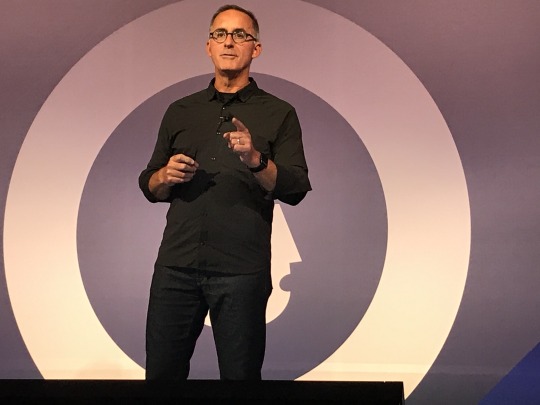
By Keith Hughes
Earlier this week, P&G CMO Jim Stengel was on stage at Advertising Week to talk about “How to Unleash the Innovators in Your Company” (he has a new book, Unleashing the Innovators), where he explored how we often have to take a look outside our four walls for the most inspiring innovation.
I was fortunate to be a part of the communications effort to launch some of P&G’s most dynamic and successful new products of the early 2000’s … category defining entries such as Swiffer, Febreze, Mr. Clean Magic Eraser and more. It was an energizing time to say the least. The person at the helm of all that innovation was former CMO Jim Stengel.
As Jim was quick to point out, the biggest problem holding back more established enterprises today is that they overemphasize in-the-moment execution at the expense of innovation. This is particularly germane to larger organizations and brands. They look from a distance with envy at smaller start-ups that are nimble enough to take calculated risks and to pursue their passions. So, the question remains, how can these larger enterprises avoid potential decline and marginalization?
In looking at hundreds of companies, Jim found a thread which bound companies that had successfully evolved. Simply put, those that were fully committed to bringing the “outside-in,” were more likely to foster innovation and reignite the energy of their own teams. Pursuit of that strategy compels going beyond mere exposure to new thinking and ways of operating to forming active partnerships with outsiders such as start-ups, who can bring other schools of thought and action bias to the table. These “outsiders” are proven to exercise a profound influence on culture change.
Becoming an innovation-led organization calls for thinking more like a venture capitalist. Instead of concentrating all your resources behind a single idea or two, success comes more often from making many smaller bets on many different smaller ideas to see which will stick. It also calls for “falling back in love” with your customers and the products or services you offer. Never losing the same type of passion that start-ups demonstrate day-in and day-out.
Jim left us with one more important thought. Innovative organizations have an “outside” leadership mentality with the courage to embrace the uncomfortable. Are you such a leader or do you work with someone who is?
Maybe it’s time to open the door and welcome some new faces in.
0 notes
Text
The Art of Collaboration

By Shelly Govila
"For millions of years, mankind lived just like the animals. Then something happened which unleashed the power of our imagination. We learned to talk and we learned to listen. Speech has allowed the communication of ideas, enabling human beings to work together to build the impossible. Mankind's greatest achievements have come about by talking, and its greatest failures by not talking. All we need to do is make sure we keep talking." — Stephen Hawking
In July this year, team members from our various global offices gathered in Kuala Lumpur to share best practices and success stories, and learn from industry leaders and communication experts. We set out to better understand Ruder Finn’s digital tools and learn how to wield these powerful weapons, all with the ultimate aim of becoming a trusted advisor for our clients, going beyond the traditional call of duty.
And so, we delved deep into a vigorous two days of exercises, sharing sessions, and insightful conversations. We learned the crucial importance of rich storytelling, and how good content, paired with the right context, could help our clients create narratives that would truly stand out from the crowd. We learned the importance of analytics, and how to incorporate digital tools into our work to drive deeper insights for our clients and their audiences.
And yet, most of all, in the midst of this inspiring and invigorating learning experience, the one thing that could not be taught through a seminar, but only learned through action, was the beauty and art of collaboration. Our teams seemed to be brimming with wild creativity, running like an electric charge through the room. We felt it collectively, and the ideas resulting from team brainstorms continued to surprise and delight us all. While role-playing scenarios, when tasked with creating an integrated multi-platform communications campaign in under 45 minutes, the teams - largely made up of strangers who had just met that morning - did not balk at the challenge. Each of us laid out our respective strengths, merged them together, addressed our weaknesses, and voila - we had a plan. And when those plans were challenged by others, we did not crumble. We looked at each other - bound by a single mission - and found alternative solutions. Within hours, we had learned to trust each other, and understood that we had become better consultants for it.
In today’s interconnected workplaces, working across borders in virtual teams is easier than ever before. As we continue to take on increasingly complex and multi-dimensional briefs from our clients, we must understand that often, the only way to pull off many of these tasks is to assemble the knowledge and skills of team members from home and abroad. Effective collaboration is only possible when we come together to achieve our shared goals. As we begin to learn more about each other’s expertise, experiences, strengths, and ambitions, we begin to develop our own emotional intelligence.
Two months have passed since the RF Academy session. During this period, many of the attendees, especially those of us based in the Asia-Pacific region, have worked on multiple creative projects together. Much like any new endeavour, collaboration comes with its own challenges - miscommunication, missed deadlines, differing visions, too many cooks, clashing egos, etc. And yet, overcoming these challenges are an integral part of how we operate as human beings and are the key to collective success. Finding the balance is where the practice of collaboration becomes an art form. And the results? They speak for themselves.
0 notes
Text
“The Essence of a Breakthrough Story in a Crowded Space”

By Lisa Carson
Every two days, more content is published on the internet than humankind produced from the start of the written word until 1998. That’s a lot, to say the least. As brands approach this marketplace of ideas, they’re confronted with a highly competitive environment that lacks precedent. If readers and consumers simply don’t have the bandwidth to take in a brand’s message, how on earth are corporations to tell their stories in a way that makes an impact?
The answer is maddeningly simple: tell stories that make people truly feel something. As I gathered with my colleagues in Kuala Lumpur in July this year to participate in RF Academy, we were all primed to ask and answer the same question: how can we create communications programs that stand apart from and above the competition? How can we better help our clients own the news cycle? As we reviewed case studies, discussed current client work, and bantered about best practices, one key learning began to crystalize: for stories to break through, they need to be about so much more than the product, service or industry. Stories need to have cultural equity and personal relevance to make an impression that sticks.
Take the widely championed Heineken video, “Worlds Apart,” that made the rounds this year. While the implicit purpose of the content was to demonstrate the universalism of sitting down for a beer with a stranger, the key emotional takeaway of the video was how we can be made better by embracing diversity. It was short, it was subtle, and it was impactful. Headlines praised the content as people around the world discussed. Did they discuss the value props of Heineken, and call out a preference for the key differentiators of a particular beer? No. They nodded to the brand with a quiet reverence that seemed to say, you get it. Market conditions, trends, offerings … all of it changes. But what savvy communicators know is that the way you make someone feel is what lasts.
And that was a crux of our conversations at the RF Academy this year: how to infuse our counsel with meaningful narrative that transcends product and present moment to make something more. How to create stories that don’t simply live in the marketplace of ideas, but compete and win within it. It’s a crowded space and, while the information we need to communicate may change from day to day, the essence of a breakthrough doesn’t. If it makes you truly and meaningfully feel, it can go far.
0 notes
Text
Many perspectives, One Global Spirit

By Brianna Rabe (Mulligan)
Ahead of attending Ruder Finn’s Academy in Kuala Lumpur, I was most excited for the chance to meet with enthusiastic and talented colleagues from across our global network, to learn about and discuss the state of public relations, and how we can work together as a collaborative team toward Ruder Finn’s vision.
My agency experience, like so many of my colleagues at Ruder Finn, is inherently based on non-siloed, cross-practice teams, often working on projects that span across digital, social, internal communications, and media relations. I have always found that this collaborative team model not only trains up better professionals who can think more broadly, but leads to complete and creative solutions and strategies for our clients. I was hopeful that the RF Academy would serve an opportunity to expand this unified team approach even further; and hear more about the different ways we all think to learn from each other; incorporating one another’s different perspectives and experiences into how we work on this side of the world.
Despite having some preconceived notions about what I thought I might learn at the Academy, what I found most interesting was that although we all came from different geographies, experiences and skill sets, there are certain things that are global in our industry. In other words, the things that separate us actually tie us together. Below are a few of my other key takeaways from our lessons and discussions at the RF Academy:
Different perspectives add unique value when taken together
“If there is any one secret of success, it lies in the ability to see things from the other person’s angle as well as your own.” - Henry Ford
True symbiosis for a team can happen when people bring different skills, experience, and perspectives together in one room. When working together, a unified team will provide unique and fully-thought out plans that take a fresh approach and nuanced thinking into consideration. This differences in experience and expectations was clear when our teams were comprised of Ruder Finn colleagues from Hong Kong, Beijing, Singapore, and New York. Each team can learn together and incorporate each other’s strengths to be the best possible partner to our clients.
Trust is the very groundwork from which all successful partnership are built
“If people like you, they will listen to you. But, if they trust you, they will do business with you.” -Zig Ziglar
Ruder Finn’s obligation to working alongside our clients to achieve success is paramount to how we conduct our business; and the trickle-down effect of day-to-day account management mirrors this commitment. Trust is built on your ability to be credible, reliable, sincere, and empathetic, and is the foundation from which we build all our client relations. This may sound intuitive, but hearing it spelled out is truly enlightening. Being our clients’ trusted partner is the most important responsibility we have; and from hearing examples like how our Chinese counterparts are driving creative campaigns to drive brand attention in a heavily regulated environment or how our Singapore team members are solving for clients’ crises underlined our discussions that when our clients trust us and we trust them, our work is exceptional.
We are on the client’s team
“Great things in business are never done by one person. They’re done by a team of people.” -Steve Jobs
Ruder Finn’s commitment to working as partners, not simply vendors, is consistently showcased in the amazing work we are able to accomplish alongside our partners. And, this promise to be on our client’s team was clear from how each Ruder Finn colleague from across the globe discussed our work or brainstormed during simulations. It’s imperative to take the time to work with our clients to identify the core problem for which we are solving, and actively listen to them to understand the breadth of what they are working for. Then, work together to think of impactful, creative, and smart solutions.
Overall, some of my biggest takeaways weren’t learning about the different ways our global teams think, but about all the ways we think the same; and reconfirming the core pillars of how to be the best possible team member and leader I can be.
1 note
·
View note
Text
Reflections from Ruder Finn Academy

By Mika Ike
Earlier this summer, I was fortunate enough to travel to Kuala Lumpur, Malaysia to attend the second-annual Ruder Finn Academy with my colleagues from around the world. Among other topics, our two-day crash course focused heavily on digital transformation.
Today, there’s so much discussion around new technologies, like artificial intelligence, and their future implications on work – what industries will be most affected, which jobs will cease to exist as a result, and so on.
But, despite the utopian tech world that’s envisioned by so many, one thing was clear to me from our discussions at Ruder Finn Academy: it still comes down to people.
Here are a few ways:
Our influence as marketers and communicators remains: Technology is no doubt a powerful tool to help shape human judgment, but it will never replace humans altogether. Analytics tools, like Ruder Finn’s Beacon, a full-service insights and analytics suite, offer significant potential to gather vast amounts of data and identify and predict patterns, but human understanding of those insights is still required. Even today’s most developed artificial intelligence machines are capable of mistakes or misunderstanding commands. The challenge looking ahead will be to figure out how to quickly and effectively bring these kinds of advanced tools together with humans to solve problems.
A focus on audience is more important than ever: In our line of work, it’s easy to get lost in the number of views, likes, and shares, and forget about the human element of communications – who we’re trying to target. We see this happen among clients as well. Take the healthcare industry, for example, which at its core serves to improve patients’ lives. There are so many ways that new technologies, like sensors and apps, could better connect doctors with patients. Yet, these technologies are not always being used in a productive way. Of about 60 doctors flash polled during a recent medical conference, 75% said they feel technology drives them farther apart from their patients, compared to the 25% who felt it brings them closer together. Across every industry, we need to keep the consumer in mind and use technology to enhance our interactions, rather than let technology alone dictate what we do.
Building a digital culture is key: While most companies acknowledge the arrival of a digital transformation, many of them aren’t currently equipped to handle it. When it comes to preparing an organization for this, it’s not just about senior leaders implementing the latest or greatest number of technologies, but about creating a culture where all employees are encouraged to embrace and develop digital skills. Immersive training sessions, like Ruder Finn Academy, are a great example of this culture-building.
As the digital transformation unfolds further, I’m excited to see its continued impact on our work here at Ruder Finn. Let’s not forget the important role we, as humans, play in implementing new technologies and what we’re trying to achieve by using them.
0 notes